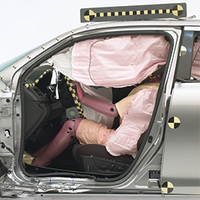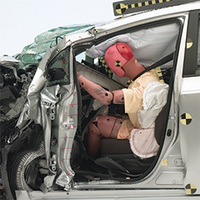IIHS-Family Cars Outperform Luxury Models In Rigorous New IIHS Crash Test
 |
Arlington Virginia December 20, 2012; A group of moderately priced midsize cars outperformed most of their luxury counterparts in a challenging new frontal crash test conducted by the Insurance Institute for Highway Safety (IIHS) on 2013 models. Of the 18 midsize family cars evaluated in the small overlap test, two earn the top rating of good, 11 earn acceptable, three earn marginal, and two are poor.
To reward 2013 models with superior crash protection, IIHS has created the TOP SAFETY PICK+ award, with the + indicating good or acceptable performance in the new small overlap test. So far, 13 models qualify for the accolade.
In contrast, just 3 of 11 midsize luxury and near-luxury cars evaluated in the inaugural round of small overlap tests earned good or acceptable ratings. Midsize moderately priced cars are the second group to be tested. The best performers in this group are the Honda Accord 4-door and Suzuki Kizashi. Both earn a good rating.
Building on its long-running vehicle ratings program for consumer information, IIHS introduced the small overlap test in 2012 to further improve occupant protection in frontal crashes. Most automakers design their vehicles for good performance in the IIHS moderate overlap frontal test and the federal government's full-width frontal test, but many haven't addressed the problem of small overlap crashes. In a 2009 IIHS study of vehicles with good ratings for frontal crash protection, small overlap crashes accounted for nearly a quarter of the frontal crashes involving serious or fatal injury to front seat occupants.
The small overlap test replicates what happens when the front corner of a car collides with another vehicle or an object like a tree or utility pole. In the test, 25 percent of a car's front end on the driver side strikes a 5-foot-tall rigid barrier at 40 mph. A 50th percentile male Hybrid III dummy is belted in the driver seat.
"It's remarkable that this group of midsize family cars did so much better than the midsize luxury car group," says Adrian Lund, IIHS president. "The difference is stunning. Thirteen of these midsize cars offer better crash protection than all but three of their luxury counterparts, and at a price that's easier on the wallet."
New safety award
To reward 2013 models with superior crash protection, IIHS has created the Top Safety Pick+ award, with the + indicating good or acceptable performance in the new small overlap test. Top Safety Pick+ winners must earn good ratings for occupant protection in at least 4 of 5 evaluations, with no less than acceptable in the fifth test. IIHS rates vehicles good, acceptable, marginal or poor based on performance in a moderate overlap frontal crash, small overlap frontal crash, side impact and rollover, plus evaluations of seat/head restraints for protection against neck injuries in rear impacts.
So far, 13 models qualify for the accolade. Winners include: the Dodge Avenger and its twin, the Chrysler 200 4-door; Ford Fusion; Honda Accord 2-door; Honda Accord 4-door; Kia Optima; Nissan Altima 4-door; Subaru Legacy and its twin, the Subaru Outback; Suzuki Kizashi and Volkswagen Passat. Two previously tested luxury models, the Acura TL and Volvo S60, also earn Top Safety Pick+. IIHS will announce additional winners as it continues to test models. Results for small SUVs are expected in the spring.
Meanwhile, 117 additional vehicles earn Top Safety Pick for 2013. To qualify for Top Safety Pick, vehicles must have good ratings for occupant protection in the moderate overlap frontal test, side impact, rollover and rear tests, regardless of their small overlap rating. IIHS first gave the Top Safety Pick award to 2006 models and has tightened criteria twice since then. Good rear test results and availability of electronic stability control became a requirement starting with 2007 models, and a good roof strength rating became a deciding factor for the 2010 model year. Stability control is no longer a separate requirement since all 2012 and later vehicles must have the feature as standard under federal rules.
IIHS gives manufacturers advance notice of planned changes. Automakers in the past have been quick to factor new IIHS evaluations into their designs, and many are on track to do the same with the introduction of the small overlap test and Top Safety Pick+.
"We've seen automakers make structural and restraint changes in response to our small overlap test," Lund says. "Five manufacturers redesigned their midsize cars to enhance small overlap crash protection."
Honda engineered both versions of the Accord to do well in the test. Ford and Nissan made running structural changes to 2013 models already in production. Subaru and Volkswagen changed airbag control modules on the production line so side curtain airbags would deploy for improved head protection.
Toyota falls short
Shoppers looking for a midprice family car will recognize some
perennial bestsellers on the Top
Safety Pick+ winners' list, including the Accord, Altima and
Fusion.
One nameplate they won't find is Toyota. The Camry, which is the top-selling midsize car in the United States, and the Prius v, a 4-door hybrid wagon, earn poor ratings for small overlap protection and are the worst performers of the midsize group. The Camry was redesigned for 2012, and the Prius v was an all-new model for 2012.
The Camry and Prius v illustrate what can go wrong in a small overlap crash, despite good ratings in IIHS tests that qualify the cars for Top Safety Pick.
Most modern cars have safety cages built to withstand head-on collisions and moderate overlap frontal crashes with little deformation, and the two Toyotas are no exception. Crush zones help manage crash energy to reduce forces on the occupant compartment. The main crush-zone structures are concentrated in the middle 50 percent of the front end. When a crash involves these structures, the occupant compartment is protected from intrusion, and front airbags and safety belts can effectively restrain and protect people inside.
 The Suzuki Kizashi earns a good overall rating and is the only midsize moderately priced car with a good rating for structure. There was only minor intrusion into the occupant compartment. |
For many vehicles, a 25 percent overlap frontal impact misses the primary structures designed to manage crash energy and results in crash forces going directly into the wheel, suspension system and firewall. Such crashes often have high levels of occupant compartment intrusion. It is not uncommon for the wheel to be forced rearward into the footwell, contributing to even more intrusion in the occupant compartment and resulting in serious leg and foot injuries. Since the impact occurs toward the car's outer edge, the vehicle has a tendency to rotate during the collision, resulting in the driver's head moving outboard, away from the frontal airbag. Real crashes of this type result in head injuries from contact with outboard structures or intruding objects such as trees or poles.
In the Camry, the force of the impact shoved the front wheel back into the footwell, bending the windshield pillar and pushing the parking brake pedal and the left outer edge of the instrument panel rearward into the driver's survival space. Likewise, there was significant intrusion in the Prius v, along with high forces on the dummy's legs and feet. The Prius v is the only car in the midsize test group to earn a poor rating for hip and thigh protection.
The Camry's driver airbag and side curtain airbag deployed, but the steering wheel moved so far to the right that the dummy's head made only minimal contact with the front airbag. The side curtain airbag didn't extend far enough forward to help prevent the dummy's head from hitting the instrument panel. In the Prius v, the side curtain airbag deployed too late in the crash to offer protection.
"Toyota engineers have a lot of work to do to match the
performance of their competitors," Lund says.
Demanding crash
The small overlap frontal test represents a severe crash. When cars strike the test barrier they tend to move sideways away from it, and the interior structures including the driver door, side window and windshield pillar move in the same direction. The dummy, however, continues forward into the path of the sideways-moving interior structures. At the same time, the steering column and driver airbag move inboard in many vehicles as the front end and occupant compartment deform. If the dummy misses the airbag or slides off it, its head and chest are unprotected.
Front airbags are calibrated to deploy in these crashes. Side airbags, especially head-protecting curtains, don't always deploy because they are designed mainly for direct side impacts. When they do deploy, they don't always do so early enough or extend far enough forward to adequately protect people. The result is an airbag gray zone with gaps between what front airbags cover and what side airbags do — if they deploy at all.
Without airbag protection, people in real-world small overlap frontal crashes can sustain head injuries from direct contact with the windshield pillar, dashboard or window sill or by hitting trees, poles or other objects. Chest injuries happen when people contact the steering wheel, door or other intruding structures.
The Accord sedan shows how safety belts and airbags work together to provide exemplary protection. The dummy stayed engaged with the Accord's front airbag, and the steering wheel remained relatively stable because there was only moderate intrusion into the occupant compartment. That meant that the driver airbag was in the right position to cushion the dummy's head and chest. The side curtain airbag extended far enough forward to prevent the dummy's head from hitting interior components.
Every midsize car evaluated earns good ratings for head, neck and chest injury risk based on measurements from dummy sensors. Similar real-world crashes, however, often result in serious upper body injuries. One possible reason for the differing results is that real people move more during a crash and are prone to be out of position at the start, compared with relatively stiff and precisely positioned crash test dummies. Not all drivers are the same size as the dummy or seated the same way. A close call for the dummy could mean an actual injury for a person. Another reason is that the frontal crash dummy IIHS uses in the small overlap test isn't good at measuring risks from lateral forces. Side crash dummies do a better job of this but can't record much of the frontal action in these tests.
"The dummy doesn't always tell us everything," Lund says. "The crash damage in these tests is like the damage we see in real-world crashes where heads and chests are injured."
Unexpected outcomes
In the Jetta test, engineers at the Vehicle Research Center witnessed a first for IIHS crash testing when the driver airbag module detached from the steering column. It happened relatively late in the crash and didn't affect the dummy's movement. Still, airbags should stay in place in crashes, so engineers had to lower the restraints and kinematics score for the marginal-rated Jetta. IIHS isn't aware of a problem with Volkswagen's airbag module in real-world crashes, and Volkswagen is investigating further.
The Kizashi's results also are unique. The car, which Suzuki introduced in the 2010 model year, is the only midsize moderately priced car to earn a good rating for structure in the small overlap test. The Kizashi also earns good ratings in the moderate overlap frontal test, side test and seat/head restraint evaluation. Its roof strength rating, however, is acceptable, so it has never qualified for Top Safety Pick.
"The Kizashi is a rare case. Its good small overlap test performance outweighs its acceptable rollover rating, so the car is a Top Safety Pick+. So far this is the only model we have evaluated to be in this situation," Lund explains. Suzuki Motor Corp. in November said it would stop selling cars in the United States.
| Midsize moderately priced cars | Midsize luxury/near luxury cars | |
| Chrysler 200 4-door | Acura TL | |
| Dodge Avenger | Volvo S60 | |
| Ford Fusion | ||
| Honda Accord 2-door | ||
| Honda Accord 4-door | ||
| Kia Optima | ||
| Nissan Altima 4-door | ||
| Subaru Legacy | ||
| Subaru Outback | ||
| Suzuki Kizashi | ||
| Volkswagen Passat |
The Insurance Institute for Highway Safety is an independent, nonprofit scientific and educational organization dedicated to reducing the losses — deaths, injuries and property damage — from crashes on the nation's roads. The Institute is wholly supported by auto insurers.



